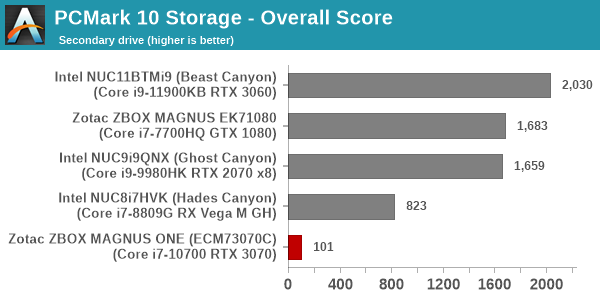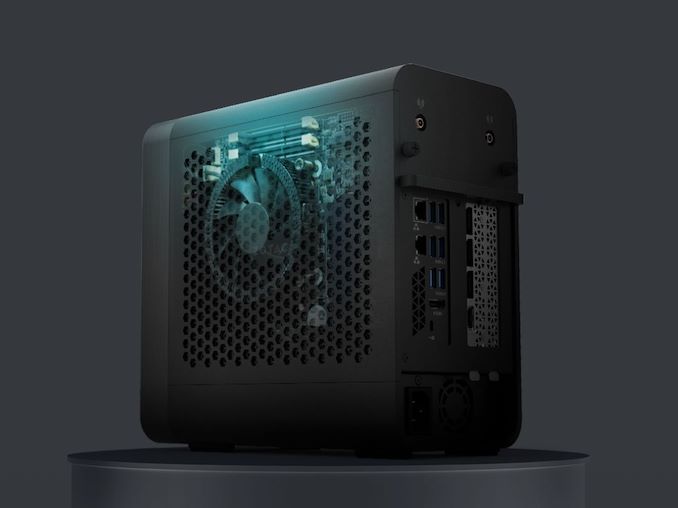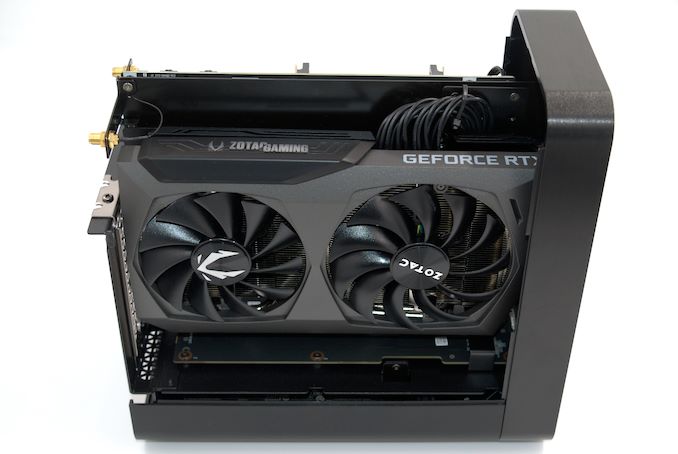Zotac ZBOX MAGNUS ONE SFF Gaming PC Review: Desktop Comet Lake Charges Up with Ampere
by Ganesh T S on August 13, 2021 10:00 AM ESTMiscellaneous Aspects and Concluding Remarks
Networking and storage are two major aspects which influence our experience with any computing system. This section presents results from our evaluation of these aspects in the Zotac ZBOX MAGNUS ONE (ECM73070C). On the storage side, one option would be repetition of our strenuous SSD review tests on the drive(s) in the PC. Fortunately, to avoid that overkill, UL PCMark 10 has a Full System Drive Benchmark storage test certain common workloads such as booting, loading games, and document processing are replayed on the target drive. The average access times and bandwidth numbers are recorded for each trace and the overall numbers contribute to a benchmark score.
Since the review configuration is a dual-drive system, we were able to process the benchmark on both the primary and secondary drives. The results are presented below.


The primary drive is a DRAM-less NVMe SSD and delivers good enough performance. The secondary drive is a hard disk (something of a rarity these days). Understandably, its performance is downright abysmal compared to flash-based secondary drives in the other mini-PCs.
On the networking front, Zotac ticks all the right boxes for gamers by integrating the Killer line of wired and WLAN adapters. The Killer adapters come with specific networking features to have fine-grained control over lag, latency, and packet loss - all of which are important for online gaming sessions. The 2.5Gbps port is also a nice upgrade over the regular gigabit ports found in most Comet Lake desktop platforms.
Coming to the business end of the review, Zotac's MAGNUS ONE is undoubtedly one of the most powerful pre-built gaming mini-PCs to appear in the market. The standard configuration leaves one of the SODIMM slots empty and that handicaps the performance of the system. A 2.5" hard disk for bulk storage is welcome in a mini-PC meant for gaming purposes. However, 1TB is too small a capacity for spinning rust in modern systems. It would have been better if Zotac had gone in for one of the 4TB HDDs. Despite these shortcomings, the 4K and 1440p gaming credentials of the system far surpass that of the Ghost Canyon NUC. The Beast Canyon NUC with the Tiger Lake processor is a more capable system, but it is not available in the market yet. The MAGNUS ONE has been selling for the past 6 months and is available for purchase today. More importantly, it is in stock - one of the few ways in which one can get hold of a high-end nVIDIA Ampere GPU without paying a premium to the scalpers.
A key difference between the MAGNUS ONE and the previous MAGNUS flagships is the upgrade aspect. It is the first system that Zotac is advertising with a user-replaceable discrete GPU. As long as the GPU to be installed consumes 220W or lesser, is not longer than 230mm (9.06 in.), and takes up only two slots at the maximum, it is possible for end users to upgrade the pre-installed RTX 3070 a year or two into the system's service lifetime.
Despite lacking premium features such as Thunderbolt 4 or Wi-Fi 6E support, Zotac has made some pleasing decisions in the chassis design such as tool-less access to the internals, ease of installing components, and the presence of easily accessible Type-C and Type-A ports in the front panel. These are aspects that future Extreme NUCs and other gaming mini-PCs would do well to incorporate.
Overall, Zotac has a winner in the MAGNUS ONE. The huge demand for the nVIDIA Ampere GPUs has allowed the company to push out the high-margin pre-built SKU into the market, rather than just selling the barebones version. The system was launched at $1900 back in January, but the same configuration now retails for $2400. The price increase is a bit unfortunate, but the availability of discrete GPUs is such that the market is able to absorb the increased pricing and still keep the product moving along. The positive aspect is that the system built around the RTX 3070 by Zotac hits all the right notes for a capable gaming mini-PC.













19 Comments
View All Comments
Samus - Sunday, August 15, 2021 - link
I'm surprised nobody has pointed out the obvious here: this thing looks better than a PS5\XBOXX while actually being smaller and more powerful. Sure it costs more but it isn't like you can actually but a PS5 or XBOXX for MSRP anyway...lemurbutton - Sunday, August 15, 2021 - link
Most people do get the PS5/XSX at MSRP. This thing is 4.8x more expensive.Threska - Sunday, August 15, 2021 - link
More closely resembles a fat Motorola Cable Modem.Spunjji - Monday, August 16, 2021 - link
"looks better than"Hmmm, I'd argue it's about the same at best? YMMV
"more powerful"
Certainly, but -
"it costs more"
As lemurbutton pointed out, it costs 4.8x more - and it's not 4.8x more powerful.
To me the comparison looks pretty favourable to the console, unless you have a specific need for a PC.
Oxford Guy - Sunday, August 15, 2021 - link
‘Overall, the system has an effective thermal solution, but that comes at the cost of fan noise. For a gaming mini-PC with a 220W TDP GPU, that is to be expected.’I see buttons for Temperatures and Power but no data about decibels (noise pollution), such as decibels-per-watt, peak noise, etc.
Since fan noise is to be expected, one would expect to be able to know how much there is of it, in order to decide if it’s worth having in order to obtain the often dubious benefit of a somewhat smaller case.
Also, does the slow RAM (in terms of the latency being 22) operate in single channel mode?
twotwotwo - Sunday, August 15, 2021 - link
With apologies for some shameless brand cheerleading, I'd love to see a similar "essentially prebuilt" SFF Ryzen option with dGPU; even a weak or past-gen dGPU could fit the non-APU chips into a smaller form factor. Retail-available APUs no longer lag the CPUs as much as they did between the Matisse launch and the 5x00G release, so maybe the difference is less dramatic now, but it's still a seemingly unfilled niche.easp - Monday, August 16, 2021 - link
I keep thinking this is a Motorola cable modem, circa 2014, when I see the hero picture for the article.aj654987 - Thursday, August 19, 2021 - link
I normally dont care much about looks of cases but for $2400 it should look cooler than this. This looks like those giant router/modem combo boxes the ISPs use, its ugly.noident - Tuesday, August 31, 2021 - link
Got this one as a barebone (1420 EUR Magnus One, + 70 EUR for 16 Gigs and 130 EUR for 1TB Samsung M2) This PC really performs as expected. The best thing is I just can put it on the desk so the child will not fiddle with any funny lights (very decent design with that glowing ring).The downside is the noise though. Since I'm playing with headphones it doesn't really bother me but taking off the headphones during gaming is like realizing you just disembarked from an airplane. Zotac should do something about the CPU and PSU fan.